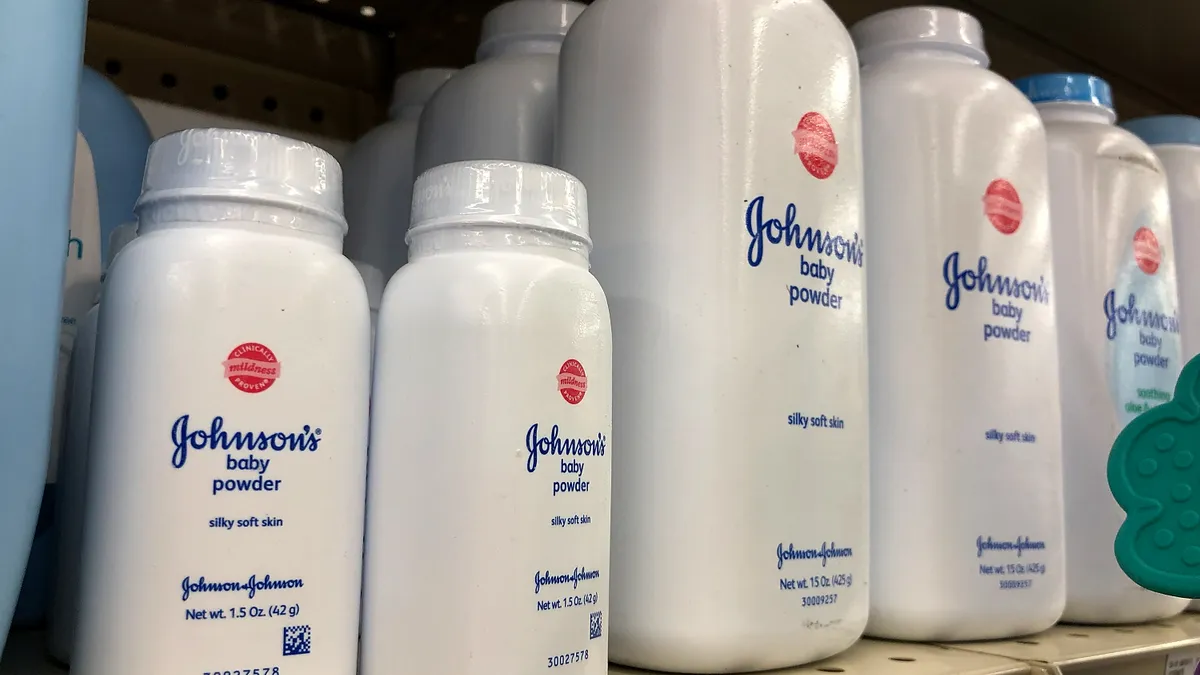Dive Brief:
- Johnson & Johnson on April 4 proposed settling tens of thousands of talc-related claims against it by offering $8.9 billion in payouts over 25 years through a new Chapter 11 bankruptcy plan filed by its subsidiary LTL Management.
- If successful, the proposal would put an end to tort claims hanging over the company from women claiming their use of Johnson & Johnson's well-known baby powder caused their gynecological cancer.
- The company is counting on the U.S. Bankruptcy Court for the District of New Jersey, which accepted its previous bankruptcy filing but was later overruled on appeal, once again accepting the bankruptcy of LTL Management. The court, along with 75% of the claimants, also must approve the settlement plan itself.
Dive Insight:
Johnson & Johnson in 2021 tried to put space between it and its talc liability by consolidating claims under LTL Management and then having the subsidiary propose settling the lawsuits for up to $2 billion as part of the bankruptcy filing.
Walling off the liability in a bankruptcy subsidiary is a closely watched maneuver known as the Texas two-step because of its roots in Texas bankruptcy law.
Michael Kaplan, the judge who presided over the first bankruptcy filing, agreed with the company that settling liability under Chapter 11 protections was an appropriate use of the code.
“The bankruptcy court is the optimal venue for redressing the harms of both present and future talc claimants in this case,” Kaplan said in a 2022 ruling that denied claimants’ effort to have the bankruptcy case dismissed.
The U.S. Court of Appeals for the Third Circuit, which looked at the ruling after it was appealed by claimants, disagreed with Kaplan, saying use of the bankruptcy process was done in bad faith because LTL Management, given its access to J&J resources, wasn’t in financial distress.
“Good intentions — such as to protect the J&J brand or comprehensively resolve litigation — do not suffice alone,” said Thomas Ambro, who wrote the unanimous opinion for the three-judge panel. “What counts to access the Bankruptcy Code’s safe harbor is to meet its intended purposes. Only a putative debtor in financial distress can do so. LTL was not. Thus we dismiss its petition.”
Betting on approval
By re-filing for bankruptcy, J&J is betting the New Jersey court will once again side with it on its use of the bankruptcy code to settle the claims against it.
It’s also counting on the court, and most of the claimants, approving the settlement plan, which more than triples the amount of money it’s offering.
“We filed the original [bankruptcy] action in good faith,” John Kim, LTL Management’s chief legal officer, said, “and, heeding the Third Circuit’s guidance, have filed this new case to effectuate that intent.”
Kim didn’t elaborate on the substance of the guidance, but the Third Circuit’s reversal of the bankruptcy court centered on the money available to LTL Management to settle the cases.
Under the terms of this latest proposal, the $8.9 billion is a present-value estimate of the liability the company faces today. It would amount to about $12 billion in nominal value over the 25-year period.
The company says it has already secured commitments to support the plan from 60,000 claimants. Under the rules, three-quarters of the claimants, as well as the bankruptcy court, would have to approve the plan. The company didn’t identify the total number of claimants it’s facing.
“This settlement is a testament to the tens of thousands of women who have battled both cancer and the court system to achieve justice for themselves,” said Alicia O’Neill of the plaintiffs’ law firm Watts Guerra, The Wall Street Journal reported. “These strong women have ensured that no other woman will be exposed to this unnecessary danger. They deserve compensation and closure.”
Not all claimants are on board.
“Even though $8.9 billion sounds like a lot of money, when you spread it out it comes out to not very much at all for the people who suffered,” said Jason Itkin, whose firm is representing about 10,000 claimants, The New York Times reported.
Should the court reject the bankruptcy filing or should it or the claimants reject the settlement plan, Johnson & Johnson faces tens of thousands of tort cases.
The company, which says its talc isn’t contaminated by cancer-causing asbestos as claimed, has already litigated a number of these cases and, by its count, has won more than it has lost.
Even so, by consolidating the remaining cases under the bankruptcy process, the claimants can get a fair settlement and more quickly than if each case had to proceed separately.
“As the Bankruptcy Court recognized [in 2022], resolving these cases in the tort system would take decades and impose significant costs on LTL and the system, with most claimants never receiving any compensation,” Erik Haas, Johnson & Johnson’s worldwide vice president of litigation, said. “Resolving this matter through the proposed reorganization plan is both more equitable and more efficient.”
The bankruptcy court is expected to rule on the filing in the next several weeks, lawyers said.











